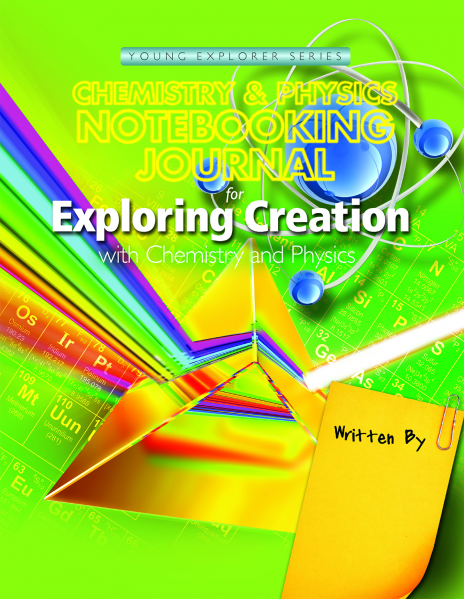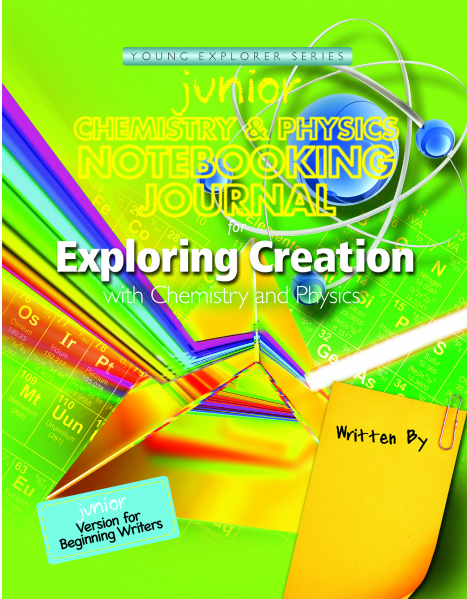
What is it about that book cover that makes science look fun and exciting even when you know it's really scary and intimidating? All I can say is Apologia Educational Ministries has done it again! I am not ashamed to say that my science bookshelf looks like this:
Obviously, we are not strangers to the wonder that is Apologia science (for the record, I paid full retail price for every single one of those books and I plan to keep them until my kids are in college. That's how much I love this homeschool science curriculum). Thus, when we heard that Apologia had written a new science text, the whole family was excited! We knew it would be coming home one way or another. Getting it for review was amazing, though. Even better, we also got the notebooking journals! We had the opportunity to review the following items:
Exploring Creation with Chemistry and Physics hardcover textbook (K-6, $39.00)
Exploring Creation with Chemistry and Physics Notebooking Journal (upper elementary, $24.00)
Exploring Creation with Chemistry and Physics Junior Notebooking Journal (lower elementary, $24.00)


As I said, this text is laid out in much the same way as previous Apologia books. To get a good feel for what that looks like, check out Chapter One in the downloads section on the textbook's webpage. Every couple of pages of reading, you'll come across a "Try This" section:
What's the significance of that? Two things: although this book masquerades as a textbook, it's not. It is a living book in the best Charlotte Mason tradition (but it is the most rigorous of science curricula - make no mistake), and if you have boys or wiggly girls, you don't have to wait too long to get to something they can get up for! Some kids can sit still and listen to books for hours. Some kids can sit still and read for hours. I've never met the little boy for whom this is true, though. And science is just one of those subjects that begs to be *tried*. Apologia knows this and gives you so many opportunities to do exactly that! As with all things homeschool, though, how much you do is always up to you.
The 275 page textbook consists of 14 chapters, each of which is designed to take two weeks or so to complete. Although there is no suggested schedule in the text, it does lend itself to natural "breaks." If you are the kind of parent who prefers a daily breakdown, I would strongly encourage the purchase of the notebooking journal, where the following beauty will greet you at the front:
The text covers the following topics (over the course of several chapters): Matter, Compound Chemistry, Mechanics, Motion, Energy, Light, Thermal Energy, Electricity, Magnetism, and Simple Machines). It is so comprehensive!
The Notebooking Journals are very similar in scope. There are a couple of differences between the standard and the junior, most notably that the junior has less writing and more coloring. If you are trying to decide which one to get, the primary determinant should be how comfortable your child is writing. If he doesn't mind it, get the standard. If he struggles or is a new writer, get the junior. You can see sample downloads on the notebook pages at Apologia's site here and here if you need more help deciding!
The journal has so many great features, including crosswords, copywork, and, Nicholas' (10) favorite: notebooking pages. When I read the chapter, Nicky has his journal in front of him to take notes as I read:
Apologies for the bad picture. Nicky writes so lightly that it is hard to make the writing visible! He takes it so seriously, though. It really makes it easier for him to focus as I read.
How We Used Apologia
It's no secret that I am not the science person in my family. My background is *social* science. What a HUGE difference that one word makes! Fortunately, Henry's degree is in biology. His present job has much to do with chemistry. For this review, then, we split duties. I read the text to the kids and oversaw notebooking/journaling activities during the week. Then by the weekend, they were ready for Henry to make it all relevant with discussion and experiments!
The best thing about doing science with someone who knows how is that he doesn't have to rely solely on the text, so he can use it as a guideline and then take off! The bad part is that, because Mom gets a break from school, there is no one to document with the camera! Still, the kids loved telling me what they did with Dad, and I knew it stuck because the whole next week, they couldn't stop talking about volume and density.
When the kids and I read about density during the week, we floated eggs in salt and regular water to learn about the effect of salt on density. When the kids told Henry about that, he began to tell them all about the Dead Sea and *its* level of salinity and the effect on density and buoyancy. The kids were, of course, thrilled to be able to show him the Dead Sea on their Bible maps. I love the synchronicity of homeschooling!
When Henry found out the kids were studying volume, he put a marshmallow in the microwave to show them that it changed in volume when it was heated, but that its mass remained the same. They really liked that experiment!
He talked to the kids about whether a pound of marshmallows or a pound of iron weighed more ;-)
He brought out our scale, a loaf of bread, and a bag of bagels. He showed the kids how the bread and the bagels weighed exactly the same - had the same mass - (it was written on the bag, but he wanted them to weigh them, too), but had different densities. He explained to them that they could easily confirm that just by biting into them!
Henry makes everything so much more exciting than I can, even with Apolgia's help, because he LOVES science. The problem is that he doesn't always know how to bring it down to the level of a 10 year-old and two 8 year-olds. This is where Apologia has saved us time after time! The book lets him know exactly what kids this age can digest. He reads the chapter, looks at the experiments, does some of them, and then his science instincts take over. The kids get the absolute best of both worlds! It just works for us! (Incidentally, we are using Biology in much the same way with Therese (12)! I guide her reading during the week, and Henry takes care of all discussion and experimentation on the weekend.)
Do you have to have a science guy or girl at home to make Apologia work for you? NO! That's just the point. Apologia is just as wonderful if you are a science genius as if you're a science dud (ahem, I'm talking to you, self!). The text talks down to no one! It respects the intelligence level of all and it gives everyone plenty to work with. I again ask you to consider my Apologia shelf. It is the best recommendation I can give for this company!
Do I Need the Notebooking Journals?
In a word, no. HOWEVER, I have now used them for this course and for Anatomy and Physiology, and they have added so much to our study. For one thing, they reassure me that we are really doing science. I guess one of the hazards of Apologia's making it so easy is that I worry that the kids won't retain things (which is silly, as my kids remember Apologia courses we did years ago). I guess I just like having the written record. I also like having the lesson plans. The notebooking journals are a very individual thing, though. The best thing to do is to look at the samples to see if they are right for your family. If you're on a tight budget, the worst mistake you could make is to think that you had to pass up this course because you couldn't also get the journals. Just get the text! It is 100% complete and wonderful! The journals are just the icing on the cake!
I hope it's clear how much my whole family loves this course. We are in the middle of Chapter 3 and can't wait to get to Thermal Energy in a few months (for some reason, that topic has captured the kids' imaginations!). To see how it has been working for other Crew families, click the banner below!







No comments:
Post a Comment